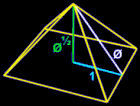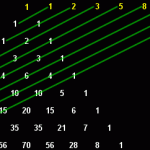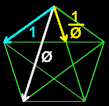The last digit of the numbers in the Fibonacci Sequence form a pattern that repeats after every 60th number: 0, 1, 1, 2, 3, 5, 8, 3, 1, 4, 5, 9, 4, 3, 7, 0, 7, 7, 4, 1, 5, 6, 1, 7, 8, 5, 3, 8, 1, 9, 0, 9, 9, 8, 7, 5, 2, 7, 9, 6, 5, 1, 6, 7, 3, 0, 3, 3, 6, 9, 5, 4, 9, 3, 2, 5, 7, 2, 9, 1 This pattern can be seen in the following list of the first 72 Fibonacci … [Read more...]
The Golden Ratio has unique mathematical properties. It is the only positive number whose square is one greater than itself. It is the only positive number whose reciprocal is one less than itself. It is also the found in limits and the Fibonacci series. These properties make it the unique solution to optimize design, in practicality and in beauty. Luca Pacioli wrote, "Without mathematics there is no art.”
Mathematics of Phi, 1.618, the Golden Number
Phi, Φ, 1.618…, has two properties that make it unique among all numbers. If you square Phi, you get a number exactly 1 greater than itself: 2.618…, or Φ² = Φ + 1. If you divide Phi into 1 to get its reciprocal, you get a number exactly 1 less than itself: 0.618…, or 1 / Φ = Φ - 1. These relationships are derived from the dividing a line at its golden section point, … [Read more...]
Powers of Phi
Phi has a unique additive relationship. The powers of phi have unusual properties in that they are related not only exponentially, but are additive as well. We know that: Phi 2 = Phi + 1 Which is the same as: Phi 2 = Phi 1 + Phi 0 And this leads to the fact that for any n: Phi n+2 = Phi n+1 + Phi n Thus each two successive powers of phi add to the next … [Read more...]
Pi, Phi and Fibonacci
Phi (Φ) and pi (Π) and Fibonacci numbers can be related in several ways: The Pi-Phi Product and its derivation through limits The product of phi and pi, 1.618033988... X 3.141592654..., or 5.083203692, is found in golden geometries: Golden Circle Golden Ellipse Circumference = p * Φ Area = p * Φ Ed Oberg and Jay A. Johnson have developed a unique expression … [Read more...]
The Phi Formula
Is the formula for Phi unique or should we say, "Hey, it's just an expression!" It's been noted by some who say they can "demystify phi" that phi is just one of an infinite series of numbers that can be constructed from the following expression using the square root (√) of integer numbers: (1+√n) / 2 It just so happens that you get phi when you let n equal 5. Let n be other … [Read more...]
Pascal’s Triangle
The Fibonacci Series is found in Pascal's Triangle. Pascal's Triangle, developed by the French Mathematician Blaise Pascal, is formed by starting with an apex of 1. Every number below in the triangle is the sum of the two numbers diagonally above it to the left and the right, with positions outside the triangle counting as zero. The numbers on diagonals of the triangle add … [Read more...]
Fibonacci 24 Repeating Pattern
The Fibonacci sequence has a pattern that repeats every 24 numbers. Numeric reduction is a technique used in analysis of numbers in which all the digits of a number are added together until only one digit remains. As an example, the numeric reduction of 256 is 4 because 2+5+6=13 and 1+3=4. Applying numeric reduction to the Fibonacci series produces an infinite series of 24 … [Read more...]
89, 109 and the Fibonacci Sequence
The reciprocal of 89, a Fibonacci number, is based on the Fibonacci series. This is a little curiousity involving the number 89, one of the Fibonacci series numbers. 1/89 is a repeating decimal fraction with 44 characters: .01123595505617977528089887640449438202247191 You can see the beginning of the Fibonacci sequence in the first 6 digits of the decimal equivalent of … [Read more...]
Number Five (5) and Phi
The number 5 is intrinsically related to Phi and the Fibonacci series. Phi can be derived from several formulas based on the number 5. The most traditional, based on the geometric construction of phi is this: This formula for phi can also be expressed all in fives as: Φ = 5 ^ .5 * .5 + .5 Another formula for phi based entirely on 5's, an original insight … [Read more...]
Geometric and Golden Means
What do we mean by "mean?" Math isn't tough, but it can be mean. The term "mean" in mathematics simply reflects a specific relationship of one number as the middle point of two extremes. Arithmetic means The arithmetic mean of 2 and 6 is 4, as 4 is equally distant between the two in addition: 2 + 2 = 4 and 4 + 2 = 6 For the arithmetic mean (b) of two numbers (a) and … [Read more...]





